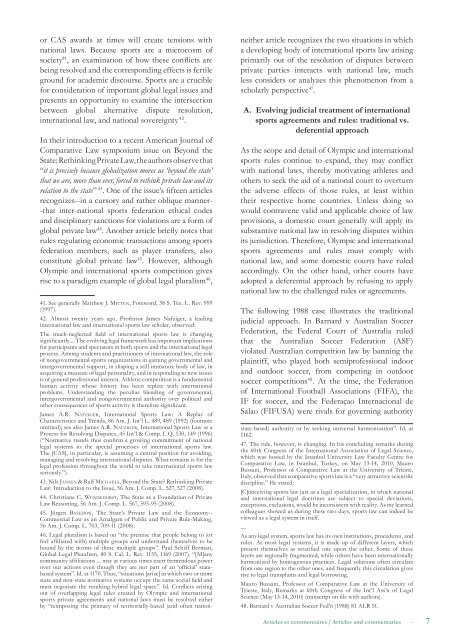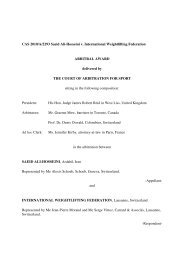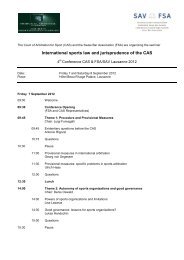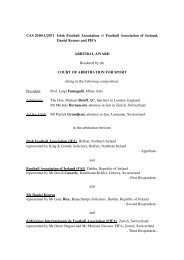(CAS) Bulletin - Tribunal Arbitral du Sport / TAS
(CAS) Bulletin - Tribunal Arbitral du Sport / TAS
(CAS) Bulletin - Tribunal Arbitral du Sport / TAS
You also want an ePaper? Increase the reach of your titles
YUMPU automatically turns print PDFs into web optimized ePapers that Google loves.
or <strong>CAS</strong> awards at times will create tensions with<br />
national laws. Because sports are a microcosm of<br />
society 41 , an examination of how these confl icts are<br />
being resolved and the corresponding effects is fertile<br />
ground for academic discourse. <strong>Sport</strong>s are a crucible<br />
for consideration of important global legal issues and<br />
presents an opportunity to examine the intersection<br />
between global alternative dispute resolution,<br />
international law, and national sovereignty 42 .<br />
In their intro<strong>du</strong>ction to a recent American Journal of<br />
Comparative Law symposium issue on Beyond the<br />
State: Rethinking Private Law, the authors observe that<br />
“it is precisely because globalization moves us ‘beyond the state’<br />
that we are, more than ever, forced to rethink private law and its<br />
relation to the state” 43 . One of the issue’s fi fteen articles<br />
recognizes--in a cursory and rather oblique manner-<br />
-that inter-national sports federation ethical codes<br />
and disciplinary sanctions for violations are a form of<br />
global private law 44 . Another article briefl y notes that<br />
rules regulating economic transactions among sports<br />
federation members, such as player transfers, also<br />
constitute global private law 45 . However, although<br />
Olympic and international sports competition gives<br />
rise to a paradigm example of global legal pluralism 46 ,<br />
41. See generally Matthew J. MITTEN, Foreword, 38 S. Tex. L. Rev. 999<br />
(1997).<br />
42. Almost twenty years ago, Professor James Nafziger, a leading<br />
international law and international sports law scholar, observed:<br />
The much-neglected fi eld of international sports law is changing<br />
signifi cantly.... The evolving legal framework has important implications<br />
for participants and spectators in both sports and the international legal<br />
process. Among students and practitioners of international law, the role<br />
of nongovernmental sports organizations in gaining governmental and<br />
intergovernmental support, in shaping a still immature body of law, in<br />
acquiring a measure of legal personality, and in responding to new issues<br />
is of general professional interest. Athletic competition is a fundamental<br />
human activity whose history has been replete with international<br />
problems. Understanding the peculiar blending of governmental,<br />
intergovernmental and nongovernmental authority over political and<br />
other consequences of sports activity is therefore signifi cant.<br />
James A.R. NAFZIGER, International <strong>Sport</strong>s Law: A Replay of<br />
Characteristics and Trends, 86 Am. J. Int’l L. 489, 489 (1992) (footnote<br />
omitted); see also James A.R. NAFZIGER, International <strong>Sport</strong>s Law as a<br />
Process for Resolving Disputes, 45 Int’l & Comp. L.Q. 130, 149 (1996)<br />
(“Normative trends thus confi rm a growing commitment of national<br />
legal systems to the special processes of international sports law.<br />
The [<strong>CAS</strong>], in particular, is assuming a central position for avoiding,<br />
managing and resolving international disputes. What remains is for the<br />
legal profession throughout the world to take international sports law<br />
seriously.”).<br />
43. Nils JANSEN & Ralf MICHAELS, Beyond the State? Rethinking Private<br />
Law: Intro<strong>du</strong>ction to the Issue, 56 Am. J. Comp. L. 527, 527 (2008).<br />
44. Christiane C. WENDEHORST, The State as a Foundation of Private<br />
Law Reasoning, 56 Am. J. Comp. L. 567, 593-95 (2008).<br />
45. Jürgen BASEDOW, The State’s Private Law and the Economy--<br />
Commercial Law as an Amalgam of Public and Private Rule-Making,<br />
56 Am. J. Comp. L. 703, 709-11 (2008).<br />
46. Legal pluralism is based on “the premise that people belong to (or<br />
feel affi liated with) multiple groups and understand themselves to be<br />
bound by the norms of these multiple groups”. Paul Schiff Berman,<br />
Global Legal Pluralism, 80 S. Cal. L. Rev. 1155, 1169 (2007). “[M]any<br />
community affi liations ... may at various times exert tremendous power<br />
over our actions even though they are not part of an ‘offi cial’ statebased<br />
system”. Id. at 1170. Thus, “situations [arise] in which two or more<br />
state and non-state normative systems occupy the same social fi eld and<br />
must negotiate the resulting hybrid legal space”. Id. Confl icts arising<br />
out of overlapping legal rules created by Olympic and international<br />
sports private agreements and national laws must be resolved either<br />
by “reimposing the primacy of territorially-based (and often nation-<br />
neither article recognizes the two situations in which<br />
a developing body of international sports law arising<br />
primarily out of the resolution of disputes between<br />
private parties interacts with national law, much<br />
less considers or analyzes this phenomenon from a<br />
scholarly perspective 47 .<br />
A. Evolving judicial treatment of international<br />
sports agreements and rules: traditional vs.<br />
deferential approach<br />
As the scope and detail of Olympic and international<br />
sports rules continue to expand, they may confl ict<br />
with national laws, thereby motivating athletes and<br />
others to seek the aid of a national court to overturn<br />
the adverse effects of those rules, at least within<br />
their respective home countries. Unless doing so<br />
would contravene valid and applicable choice of law<br />
provisions, a domestic court generally will apply its<br />
substantive national law in resolving disputes within<br />
its jurisdiction. Therefore, Olympic and international<br />
sports agreements and rules must comply with<br />
national law, and some domestic courts have ruled<br />
accordingly. On the other hand, other courts have<br />
adopted a deferential approach by refusing to apply<br />
national law to the challenged rules or agreements.<br />
The following 1988 case illustrates the traditional<br />
judicial approach. In Barnard v Australian Soccer<br />
Federation, the Federal Court of Australia ruled<br />
that the Australian Soccer Federation (ASF)<br />
violated Australian competition law by banning the<br />
plaintiff, who played both semiprofessional indoor<br />
and outdoor soccer, from competing in outdoor<br />
soccer competitions 48 . At the time, the Federation<br />
of International Football Associations (FIFA), the<br />
IF for soccer, and the Federaçao Internacional de<br />
Salao (FIFUSA) were rivals for governing authority<br />
state-based) authority or by seeking universal harmonization”. Id. at<br />
1162.<br />
47. The tide, however, is changing. In his concluding remarks <strong>du</strong>ring<br />
the 60th Congress of the International Association of Legal Science,<br />
which was hosted by the Istanbul University Law Faculty Centre for<br />
Comparative Law, in Istanbul, Turkey, on May 13-14, 2010, Mauro<br />
Bussani, Professor of Comparative Law at the University of Trieste,<br />
Italy, observed that comparative sports law is a “very attractive scientifi c<br />
discipline.” He stated:<br />
[C]onceiving sports law just as a legal specialization, in which national<br />
and international legal doctrines are subject to special deviations,<br />
exceptions, exclusions, would be inconsistent with reality. As my learned<br />
colleagues showed us <strong>du</strong>ring these two days, sports law can indeed be<br />
viewed as a legal system in itself.<br />
....<br />
As any legal system, sports law has its own institutions, proce<strong>du</strong>res, and<br />
rules. As most legal systems, it is made up of different layers, which<br />
present themselves as stratifi ed one upon the other. Some of these<br />
layers are regionally fragmented, while others have been internationally<br />
harmonized by homogenous practices. Legal solutions often circulate<br />
from one region to the other ones, and frequently this circulation gives<br />
rise to legal transplants and legal borrowing.<br />
Mauro Bussani, Professor of Comparative Law at the University of<br />
Trieste, Italy, Remarks at 60th Congress of the Int’l Ass’n of Legal<br />
Science (May 13-14, 2010) (transcript on fi le with authors).<br />
48. Barnard v Australian Soccer Fed’n (1988) 81 ALR 51.<br />
Articles et commentaires / Articles and commentaries<br />
-<br />
7





